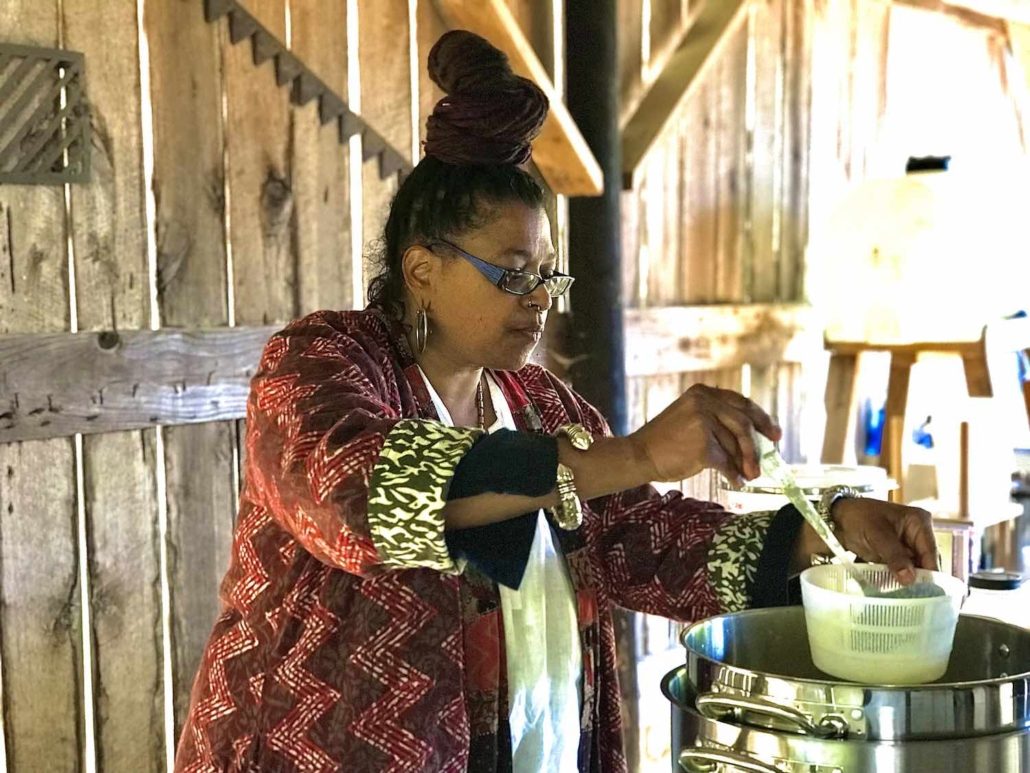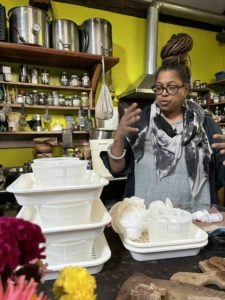Presented by the John C. Campbell Folk School
CHEESEMAKING
How to turn your kitchen into a home creamery
BY AMY BESS COOK | INSTRUCTION BY SOIRÉE-LEONE
***
What is it about cheese that makes it so universally beloved? Maybe it’s the obvious “yum” factor—but cheese is not only delicious, it’s also an excellent source of nutrients. Over the ages, it’s won an exalted reputation as a versatile food that can be created from basic ingredients, then (in the case of aged cheeses) stored away until most needed or desired. Dare we say cheese is downright essential?
What’s more, many cheeses are easy to make on your own. Below we outline the process for all you curious turophiles (translation: cheese fiends) to learn to make a delicious cream cheese.
As a guide, we turned to writer, teacher and fermentation expert Soirée-Leone. Originally hailing from an off-the-grid homestead in Maine, she practiced urban homesteading in San Diego before settling on a 57-acre farm in Tennessee. In her work, she encourages students to explore home fermentation as a way to ensure food security, influence food distribution systems and minimize waste.
“Fermentation and food preservation broadly offers an opportunity for people to preserve their local bounty while enjoying delicious foods,” she says.
Here we offer a recipe for luscious cream cheese. While not meant to be an exhaustive explanation of the process, we hope it inspires you to research the topic further or enroll in an upcoming course at the John C. Campbell Folk School.
Ready to begin making cheese?

Cheesemaking expert Soirée-Leone teaching a course at Highland Realm Blueberry Farm in Hampshire, Tennessee. Photo by Chris Probasco.
Collect Your Ingredients
To begin, you will only need a few ingredients: milk, cultures, rennet and salt.
Soirée-Leone recommends using nonhomogenized, pasteurized (but not ultrapasteurized) milk from a local dairy.
“We are uniquely positioned in our home cheesemaking practices,” she says, “to make cheeses that reflect our local terroir.”
To achieve reliable results, she recommends that beginning cheesemakers use commercial rennet (the enzyme that coagulates the milk) and commercial cultures.
Gather Your Tools
One appealing aspect of cheesemaking is that, for many basic recipes, it requires very little in the way of specialized equipment. You’ll want to make sure you sterilize any tools you do gather, along with your work space, with your preferred food-grade sanitizer.
- Nonreactive stockpot (stainless or enameled cast iron) or stoneware crock with lid, 1 gallon capacity
- Large bowl
- Thermometer
- Measuring spoons or gram scale
- Small baggies
- Small dish and spoon
- Slotted spoon or skimmer
- Towels or blankets to wrap stockpot or crock with lid to keep it warm
- Colander or strainer
- Butter muslin
- Rod or hook to hang cheese to drain
Make the Cheese
You can make this cream cheese to serve with bagels at your next brunch or book club gathering. While quick and easy, the process does take 48 hours from start to finish, most of which is hands-off. You may find that starting in the evening makes it easier to work into your schedule.
Ingredients
1 gallon pasteurized half and half (or adjust recipe accordingly)
0.2 gram (⅛ teaspoon) culture *Flora Danica mesophilic culture preferred. This is sold in a package suitable for culturing 50 gallons of milk. After opening the package, divide the Flora Danica into batch sizes by putting 0.2 gram (⅛ teaspoon) into small baggies and store all the bags in the empty Flora Danica bag closed tightly inside another plastic bag in the freezer.
1 tablet rennet diluted in 1/4 cup unchlorinated water *Walcoren is a non-GMO, animal-based rennet sold in tablets suitable for 1-gallon batches of cream cheese
Process
Designate a spot where a stockpot or crock of half-and-half can sit undisturbed overnight, wrapped in towels and/or blankets.
Warm pot or crock with hot tap water.
Pour half-and-half into a stockpot or crock.
Check the temperature.
Warm half-and-half gently (approximately 1 degree per minute) by putting the stockpot of milk in a bowl filled with hot tap water.
Once half-and-half is at target range of 86° to 88°F, move it to its designated spot.
Sprinkle Flora Danica on the surface of the half-and-half and allow the culture to hydrate for 5 minutes.
In gentle up-and-down motions, use a slotted spoon or skimmer to stir in the culture for 1 minute.
Cover the stockpot or crock and allow half-and-half to ripen for 1 hour.
Crush 1 Walcoren rennet tablet and stir to dissolve in ¼ cup of chlorine-free, lukewarm water.
Add diluted rennet to the half-and-half by pouring solution over a skimmer or slotted spoon over the entire surface of the half-and-half. With gentle upand-down motions, stir in the rennet for 1 minute.
Put the lid on the stockpot or crock. Wrap up in towels or blankets and leave undisturbed for 12 to 24 hours.
Look for the curd pulling away from the sides of the stockpot or crock. If you have pH strips or a pH meter, the target pH is 5.1 to 4.9.
Rinse butter muslin and drape over a colander over a large bowl.
Scoop curd into butter muslin.
Tie corners of butter muslin to form a pouch. Use a rod or hook to hang the cheese over a bowl or stockpot to drain. Capture whey and dispose of it in the compost or garden.
Drain until the preferred consistency, and reposition the cheese every 2 to 4 hours in the butter muslin to ensure even draining.
Salt the drained cheese. Store in a tightly lidded container in the fridge, and enjoy within a week or so.
THE JOHN C. CAMPBELL FOLK SCHOOL
Intro to Fermentation and Natural Cheesemaking
Aug. 30–Sept. 2
For a more comprehensive review of natural cheesemaking—and a broader introduction to the fermentation of vegetables, fruits and beans—check out Soirée-Leone’s weekend-long course at the John C. Campbell Folk School.
Located about two hours east of Asheville on a beautiful mountain campus, the John C. Campbell Folk School offers week-long and weekend-long courses on everything from baking and cooking to painting, writing and woodworking. View the 2024 course schedule at folkschool.org.
To learn more about Soirée-Leone, check out her website and follow her on Instagram.
Save
Save
Save
Save
Save
Save
Save
Save
Save
Save

Cheesemaking and fermentation expert Soirée-Leone. Photo by Jenny Novoa.
THE WEEKLY REVEL
Sign up for your free handpicked guide to enjoying life around Asheville.
Available weekly from May to October.





